Bryan L. Programmable controllers. Theory and implementation
Подождите немного. Документ загружается.

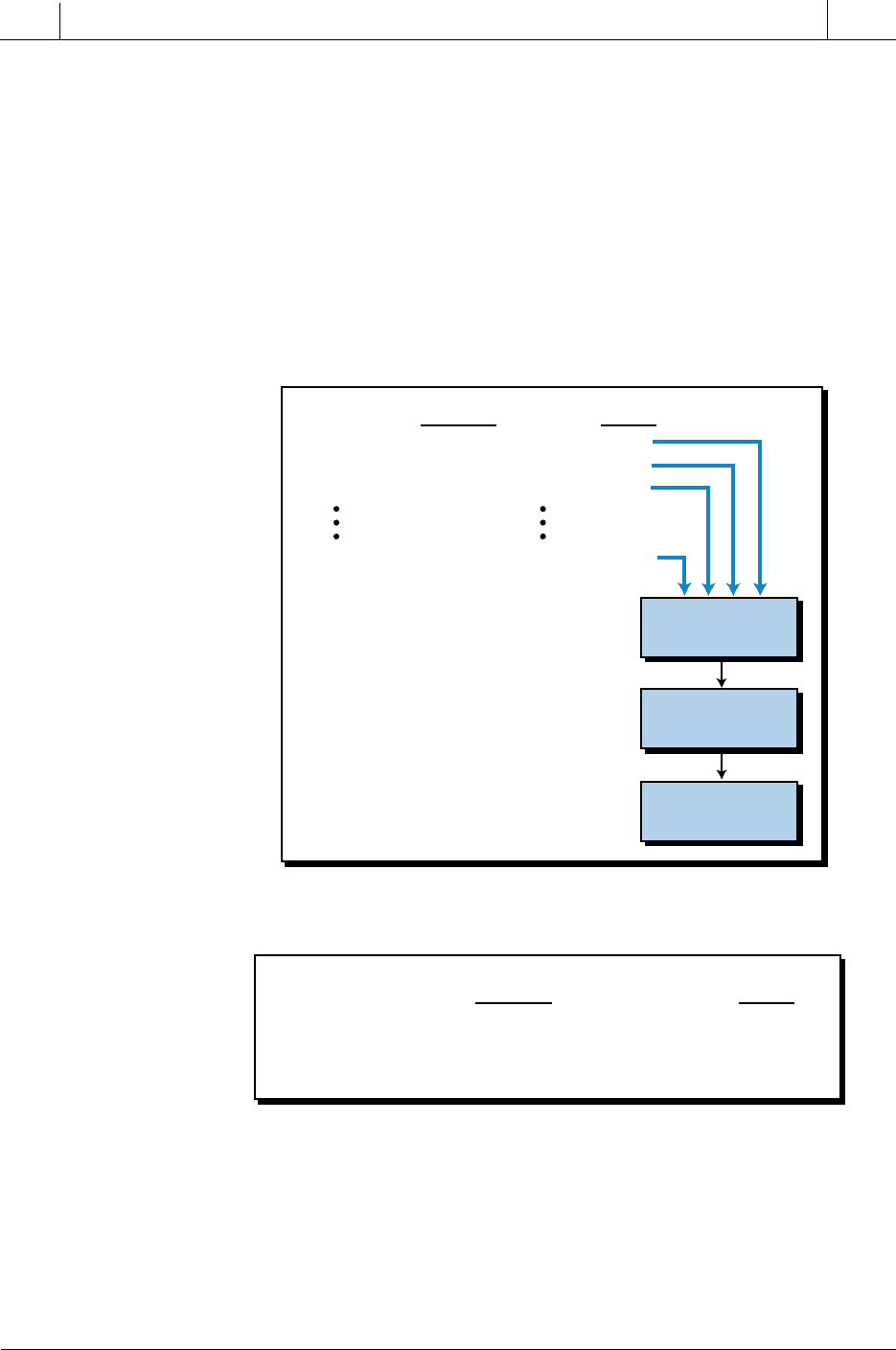
809
CHAPTER
17
Fuzzy
Logic
SECTION
5
Advanced PLC
Topics and Networks
Industrial Text & Video Company 1-800-752-8398
www.industrialtext.com
Rule Evaluation. Fuzzy logic is based on the concept that most complicated
problems are formed by a collection of simple problems and can, therefore,
be easily solved. Fuzzy logic uses a reasoning, or inferencing, process
composed of IF...THEN rules, each providing a response or outcome.
Basically, a rule is activated, or triggered, if an input condition satisfies
the IF part of the rule statement. This results in a control output based on the
THEN part of the rule statement. In a fuzzy logic system, many rules may
exist, corresponding to one or more IF conditions (see Figure 17-18). A rule
may also have several input conditions, which are logically linked in either an
AND or an OR relationship to trigger the rule’s outcome (see Figure 17-19).
Figure 17-18. Multiple rules in a fuzzy system.
Figure 17-19. Rules with multiple input conditions linked in AND and OR relationships.
Sometimes, more than one rule is triggered at a time in a fuzzy control
process. In this case, the controller evaluates all the rules to arrive at a single
outcome value and then proceeds to the defuzzification process. For
instance, if two inputs are logically ANDed or ORed in several rules, then
they will produce several outcomes, of which only one will be logically added
Logical sum of
all actions
Control output
to field device
Defuzzification
Rule 1: IF
A
1
THEN
Y
1
Rule 2: IF
A
2
THEN
Y
2
Rule 3: IF
A
3
THEN
Y
3
Rule 4: IF
A
n
THEN
Y
n
Condition Action
Rule 1: IF
A
1
AND
B
1
AND
C
1
THEN
Y
1
Rule 2: IF
A
2
OR
B
2
THEN
Y
2
Rule 3: IF (
A
3
AND
B
3
) OR
C
3
THEN
Y
3
Condition Action
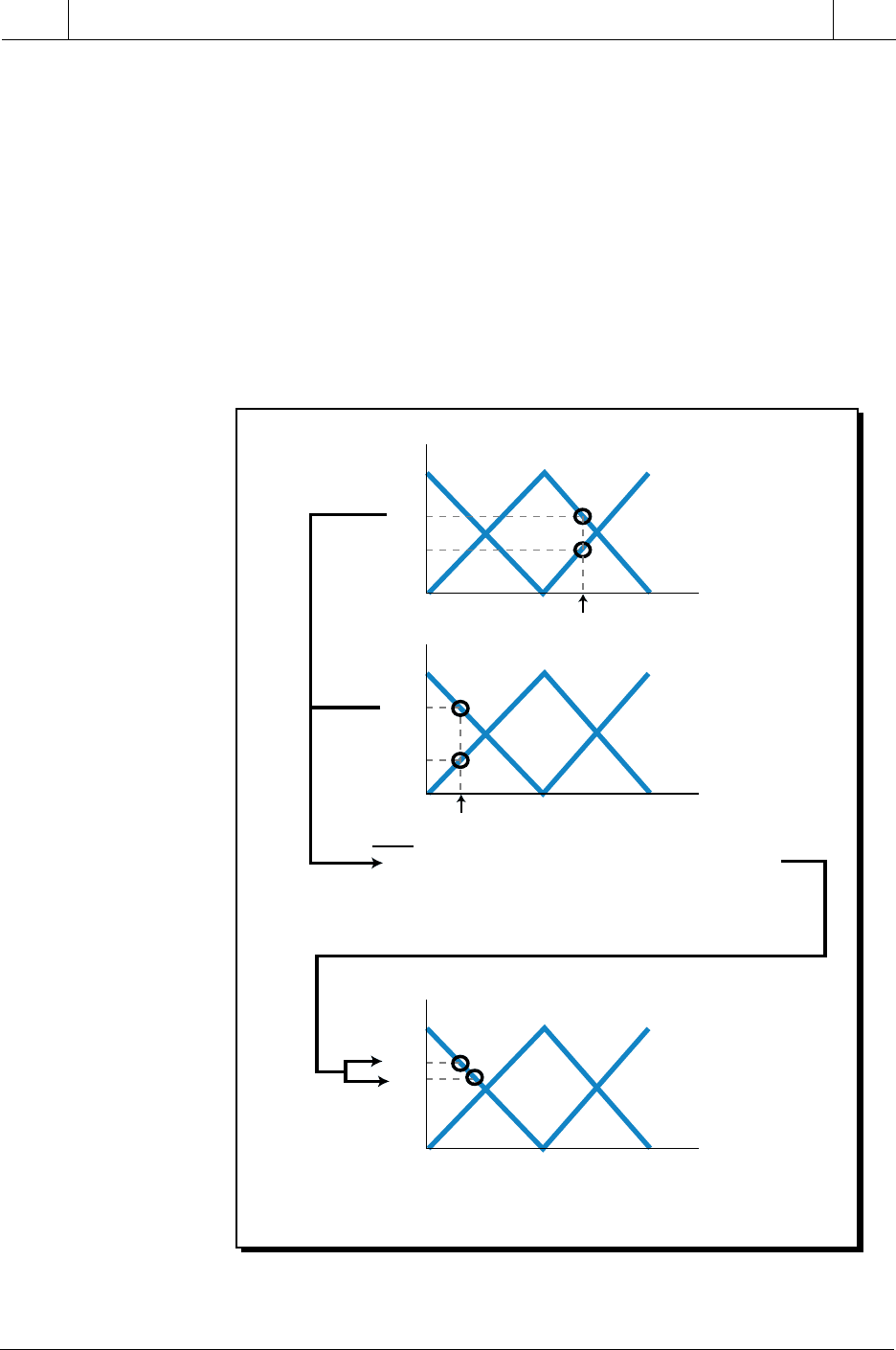
810
SECTION
5
Advanced PLC
Topics and Networks
Industrial Text & Video Company 1-800-752-8398
www.industrialtext.com
CHAPTER
17
Fuzzy
Logic
to determine the final outcome. Figure 17-20a illustrates an example of two
fuzzy inputs, X
1
and X
2
, and one fuzzy output, Y
1
. The rules shown in Figure
17-20b represent four of nine possible rules that cover the two inputs. The
four shown, however, cover the four possible triggering points for the two
input readings, X
1
and X
2
. Given the input values in Figure 17-20a, the inputs
will trigger rule 1 because X
1
= ZR AND X
2
= NL. This will generate two
outputs for Y
1
= NL, one at a grade of 0.6 (due to the input value of X
1
) and the
other at a grade of 0.75 (due to the value of X
2
). In a fuzzy logic situation where
a two-input rule with an AND relationship produces two outcome values, the
controller will choose the outcome with the lowest grade, in this case 0.6NL.
If the rule utilizes OR logic, the chosen outcome will be the one with the
Figure 17-20. Fuzzy processing example showing (a) two fuzzy input values, (b) the four
rules that they trigger, and (c) the resulting output.
Input
X
1
0.6
1
0
0.4
Grade
1
2
3
4
IF
X
1
= ZR
IF
X
1
= ZR
IF
X
1
= PL
IF
X
1
= PL
AND
X
2
= NL
AND
X
2
= ZR
AND
X
2
= NL
AND
X
2
= ZR
THEN
Y
1
= NL
THEN
Y
1
= ZR
THEN
Y
1
= PL
THEN
Y
1
= PL
Rule
X
1
ZRNL PL
Input
X
2
0.75
1
0
0.25
Grade
X
2
ZRNL PL
Output
Y
1
0.75
1
0
0.6
Grade
ZRNL PL
The logical AND function specifies that the
fuzzy controller will select the lowest grade
(0.6NL) as the outcome of the rule.
(a)
(b)
(c)
due to
X
2
due to
X
1

811
CHAPTER
17
Fuzzy
Logic
SECTION
5
Advanced PLC
Topics and Networks
Industrial Text & Video Company 1-800-752-8398
www.industrialtext.com
Figure 17-21. Omron’s fuzzy logic controller in a PLC system.
largest grade. If rule 1 in Figure 17-20 had used an OR function instead of an
AND function, then the controller would have selected the Y
1
= 0.75NL
outcome, the largest of the two outcomes.
Different fuzzy logic controllers have different rule evaluation capabilities.
The fuzzy logic controller from Omron Electronics shown in Figure 17-21,
for example, is capable of handling eight inputs and four outputs, where each
input can be represented by a maximum of seven membership functions for
a total of 56 membership functions (8 × 7). The controller also allows a
maximum of 128 programmed rules. Each rule can have up to eight input
conditions (which can be logically ANDed or ORed) and two outcomes.
Fuzzy logic rules with two inputs are often represented in matrix form to
represent AND conditions. For example, Figure 17-22 illustrates a 3 × 3
matrix (9 rules) that uses two inputs, X
1
and X
2
, and one output Y
1
. One
advantage of this matrix representation is that it makes it easy to represent
all the rules for a system. A five-label system translates into a 5 × 5 matrix
with 25 rules, while a seven-label system produces a 7 × 7 matrix with 49
Figure 17-22. Fuzzy logic rule matrix.
Courtesy of Omron Electronics, Schaumburg, IL
NL ZR PL
ZRNL NL NL
PL ZR PL
NL
ZR
PL NL ZR
X
1
X
2
IF
X
1
= NL AND
X
2
= ZR THEN
Y
1
= PL
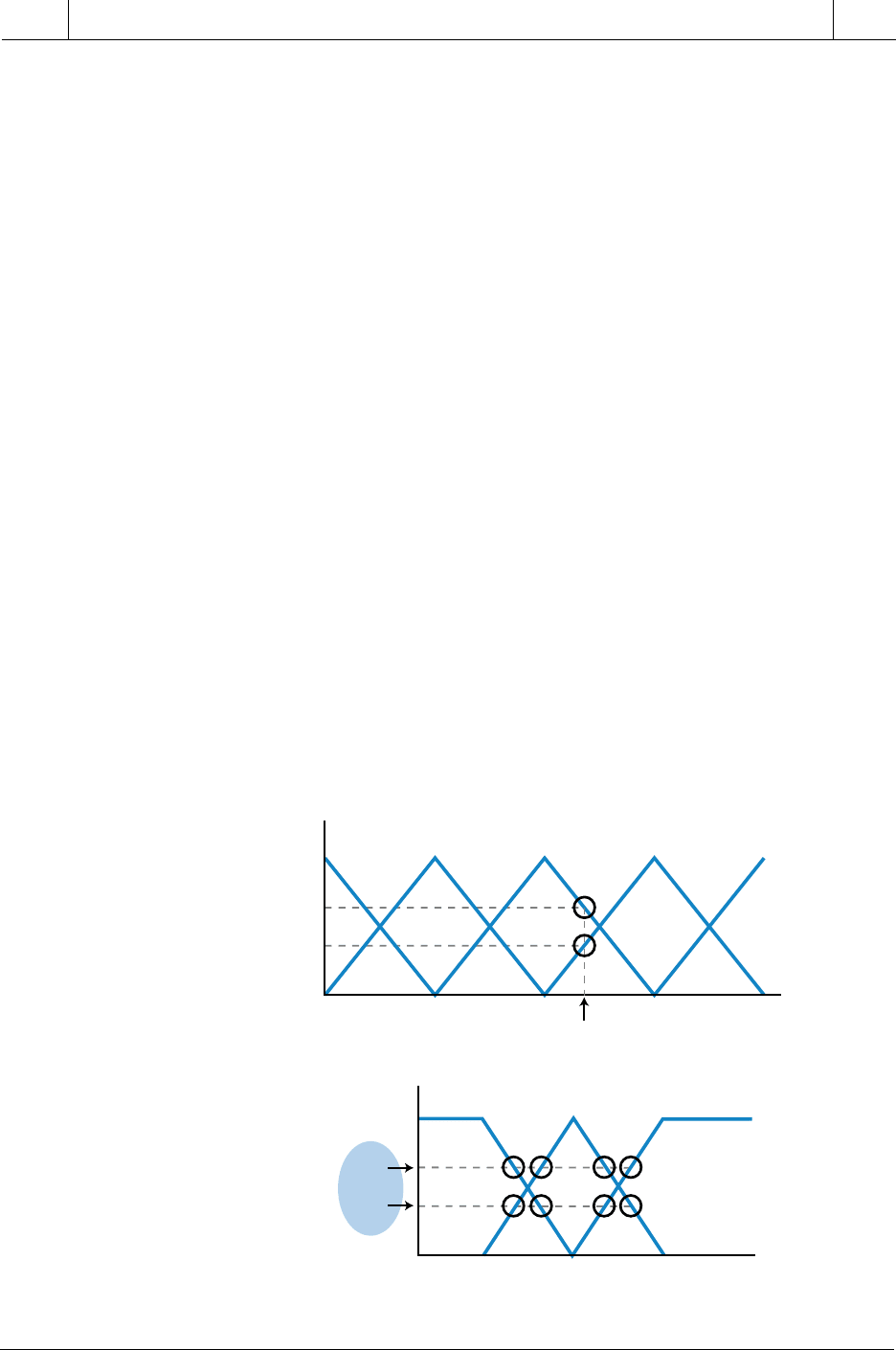
812
SECTION
5
Advanced PLC
Topics and Networks
Industrial Text & Video Company 1-800-752-8398
www.industrialtext.com
CHAPTER
17
Fuzzy
Logic
rules. An even membership function combination (e.g., a system with 6 labels
for one input and 4 labels for another) will have a 24-rule matrix. When more
than three inputs are used, the matrix becomes more difficult to represent,
since it becomes a three-dimensional matrix resembling a cube (three inputs).
In this type of complicated system, the rules would be broken down into
several two-dimensional matrices.
Fuzzy Outcome Calculations. Once a rule is triggered, meaning that the
input data belongs to a membership function that satisfies the rule’s IF
statement, the rule will generate an output outcome. This fuzzy output is
composed of one or more membership functions (with labels), which have
grades associated with them. The outcome’s membership function grade is
affected by the grade level of the input data in its input membership function.
In Figure 17-23a, the fuzzy input FI of 60% belongs to two membership
functions, ZR and PS, corresponding to the grades of 0.6 and 0.4, respec-
tively. These two grades will have an impact on the amount of the output (see
Figure 17-23b) by intersecting the output membership functions at the same
grade levels (0.6 and 0.4). However, the output membership function that is
selected for the final output value depends on the user’s programming of the
IF...THEN rules.
For example, in Figure 17-24, the input triggers rules 3 and 4 because the
input FI belongs to membership functions ZR and PS. These rules indicate
that both fuzzy output action ZR and action PL must be applied to the
process. These output actions will be applied at a value that corresponds to the
grades generated in the input membership functions (i.e., output 0.6ZR and
Figure 17-23. (a) Fuzzy input grades and (b) the resulting output grades.
0% 100%
0.6
1
0
0.4
Grade
Input
F
I
NM NS ZR PS PM
Input 60%
0% 100%
0.6
1
0
0.4
Grade
NM ZR PM
Output
FO
(a)
(b)
Potential
output
choices
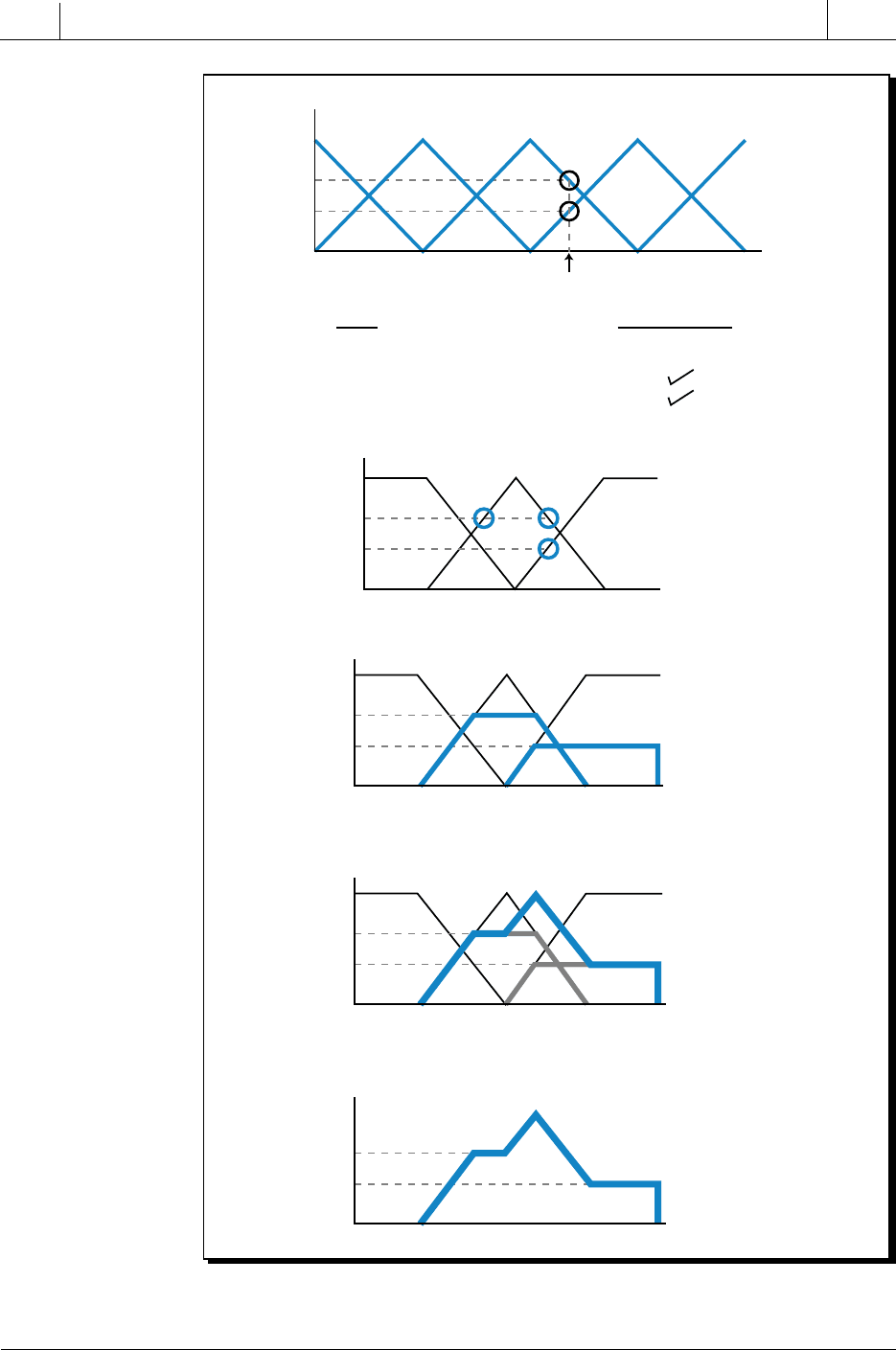
813
CHAPTER
17
Fuzzy
Logic
SECTION
5
Advanced PLC
Topics and Networks
Industrial Text & Video Company 1-800-752-8398
www.industrialtext.com
Figure 17-24. Fuzzy logic process: (a) inputs, (b) rules, (c) outputs, (d) output curves,
(e) combined output curve, and (f) the output signal for the field device.
0% 100%
0.6
1
0
0.4
Grade
Output 1 is 60% (or 0.6) of the ZR output.
Output 2 is 40% (or 0.4) of the PL output.
(d)
0% 100%
0.6
1
0
0.4
Grade
The result of adding outputs 1 and 2 is a
new curve that defines the final output.
(e)
NL ZR PL
NL ZR PL
Output
FO
Output
FO
0% 100%
0.6
1
0
0.4
Grade
(f)
Output
FO
0% 100%
0.6
1
0
0.4
Grade
1
2
3
4
5
IF
FI
= NM THEN
FO
= NL
IF
FI
= NS THEN
FO
= ZR
IF
FI
= ZR THEN
FO
= ZR
IF
FI
= PS THEN
FO
= PL
IF
FI
= PM THEN
FO
= PL
Rule
Rules Triggered
NL ZR PL
Output
FO
0% 100%
0.6
1
0
0.4
Grade
Input
FI
NM NS ZR PS PM
Input 60%
(a)
(b)
(c)
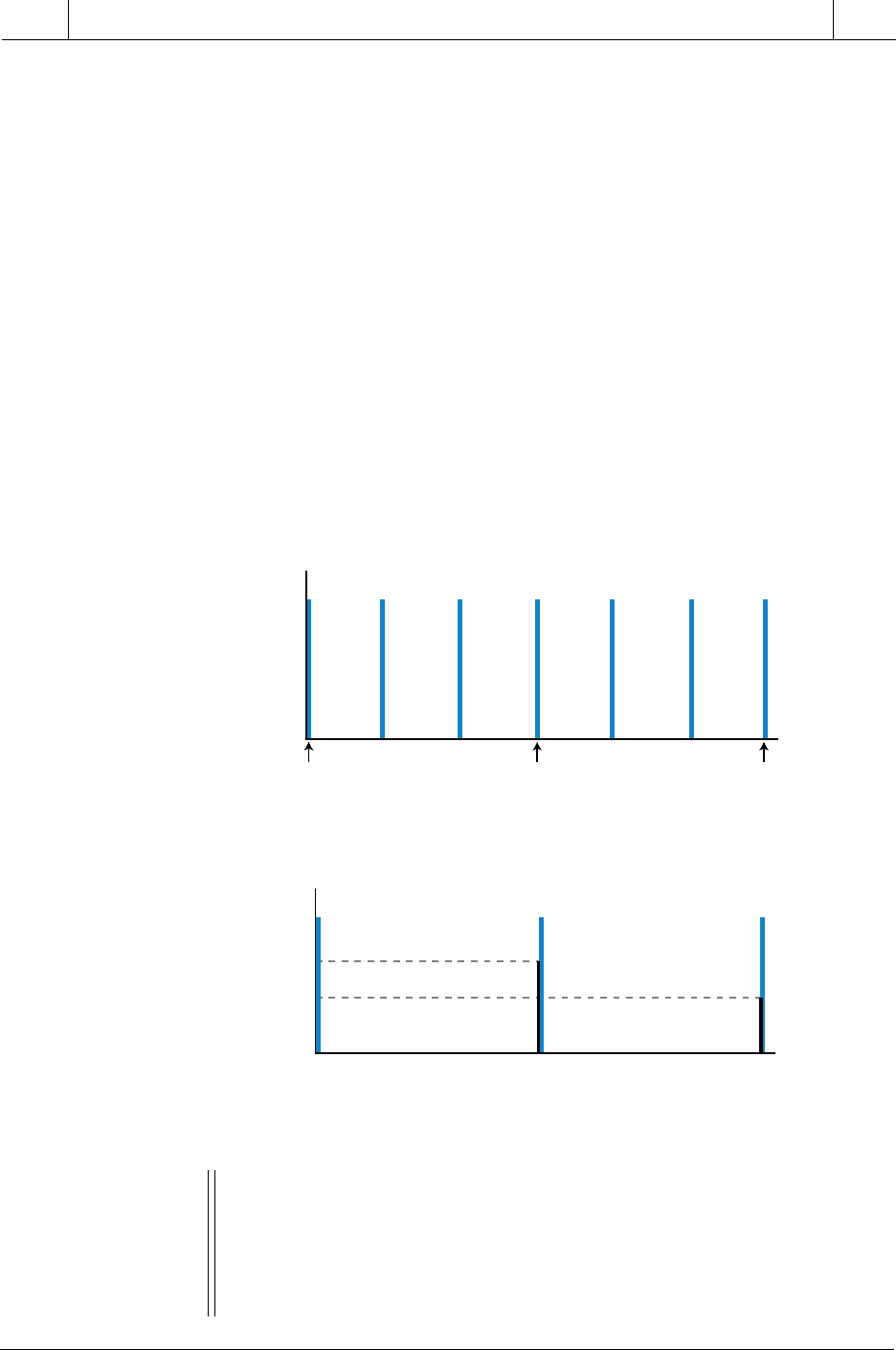
814
SECTION
5
Advanced PLC
Topics and Networks
Industrial Text & Video Company 1-800-752-8398
www.industrialtext.com
CHAPTER
17
Fuzzy
Logic
0.4PL). Note that the 0.6 grade is applied to output ZR and the 0.4 grade is
applied to output PL because the user programmed the rules that way. Figure
17-24c shows these two outputs. To arrive at a final outcome value, the fuzzy
logic controller logically adds both fuzzy outcomes to produce an aggregate
outcome curve, illustrated in Figure 17-24e. The controller then generates an
output signal (during defuzzification) that controls the process’s field device
(e.g., valve, motor, etc.) according to the input data (see Figure 17-24f).
A fuzzy logic controller may implement its output membership functions
as noncontinuous functions that resemble spikes rather than geometrical
shapes. Figure 17-25 illustrates an example of seven output membership
functions represented as spikes and described by labels. Each label has a
relationship to the output interface. For example, each label shown in Figure
17-25 corresponds to a value between 0 and 4095 counts. As another
example, the three output membership functions presented in Figure 17-24
can be represented as noncontinuous spikes (see Figure 17-26), where the
outcome grade levels specify 0.6 of ZR and 0.4 of PM.
EXAMPLE 17-2
Figure 17-27 illustrates a three–membership function fuzzy set and the
three rules that dictate the outcomes. For a fuzzy input (
FI
) of 37.5%,
(a) indicate the triggered rules and the outcome membership func-
tions selected and (b) illustrate the logical sum of the selected outputs.
Figure 17-25. Output membership functions represented as noncontinuous functions.
Figure 17-26. The three output membership functions from Figure 17-24 shown as spikes.
Grade
NM NS ZR PS PM PL
1
0
NL
0 counts 2048 counts 4095 counts
Output
Grade
ZR PL
1
0.6
0.4
0
NL
0 counts 2048 counts 4095 counts
Output
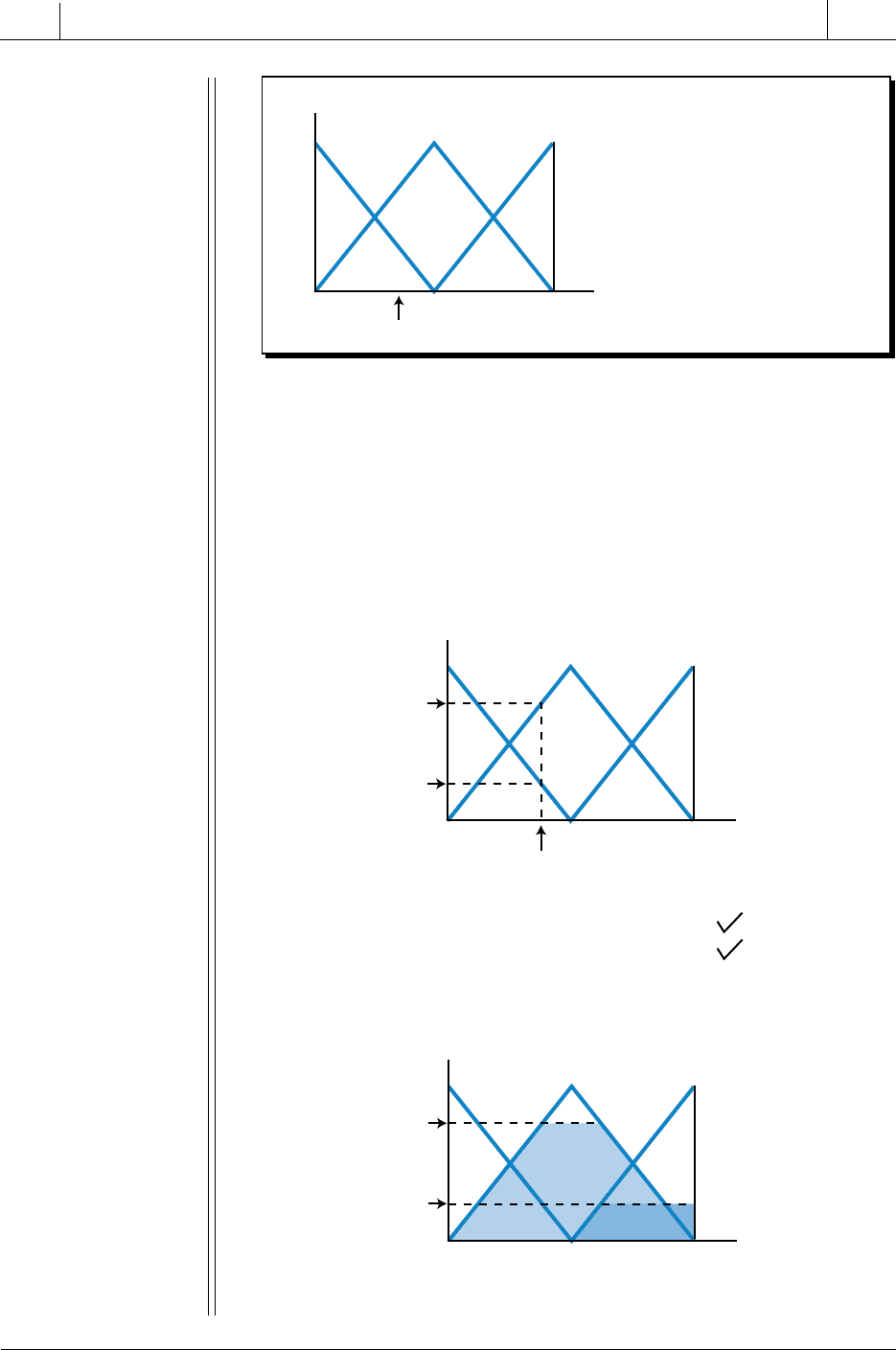
815
CHAPTER
17
Fuzzy
Logic
SECTION
5
Advanced PLC
Topics and Networks
Industrial Text & Video Company 1-800-752-8398
www.industrialtext.com
Figure 17-27. Three–membership function fuzzy set and its rules.
SOLUTION
(a) Figure 17-28a shows the two rules triggered (rules 1 and 2) by the
37.5%
FI
input, where
FI
intercepts the input membership functions at
0.25NL and 0.75ZR. Consequently, these rules trigger output values
of 0.25PL and 0.75ZR, as shown in Figure 17-28b.
Figure 17-28. (a) Inputs triggered by the rules and (b) the resulting outputs.
0% 100%
1
0
Grade
NL ZR PL
Input
FI
37.5%
IF
FI
= NL THEN
FO
= PL
IF
FI
= PL THEN
FO
= NL
IF
FI
= ZR THEN
FO
= ZR
1
3
2
0.25PL
0.75ZR
0.75
0.25
(a)
Rule Outcome
Rule
Triggered
0% 100%
1
0
Grade
NL ZR PL
Output
FO
0.75
0.25
(b)
0% 100%
1
0
Grade
NL ZR PL
Input
FI
37.5%
IF
FI
= NL THEN
FO
= PL
IF
FI
= PL THEN
FO
= NL
IF
FI
= ZR THEN
FO
= ZR
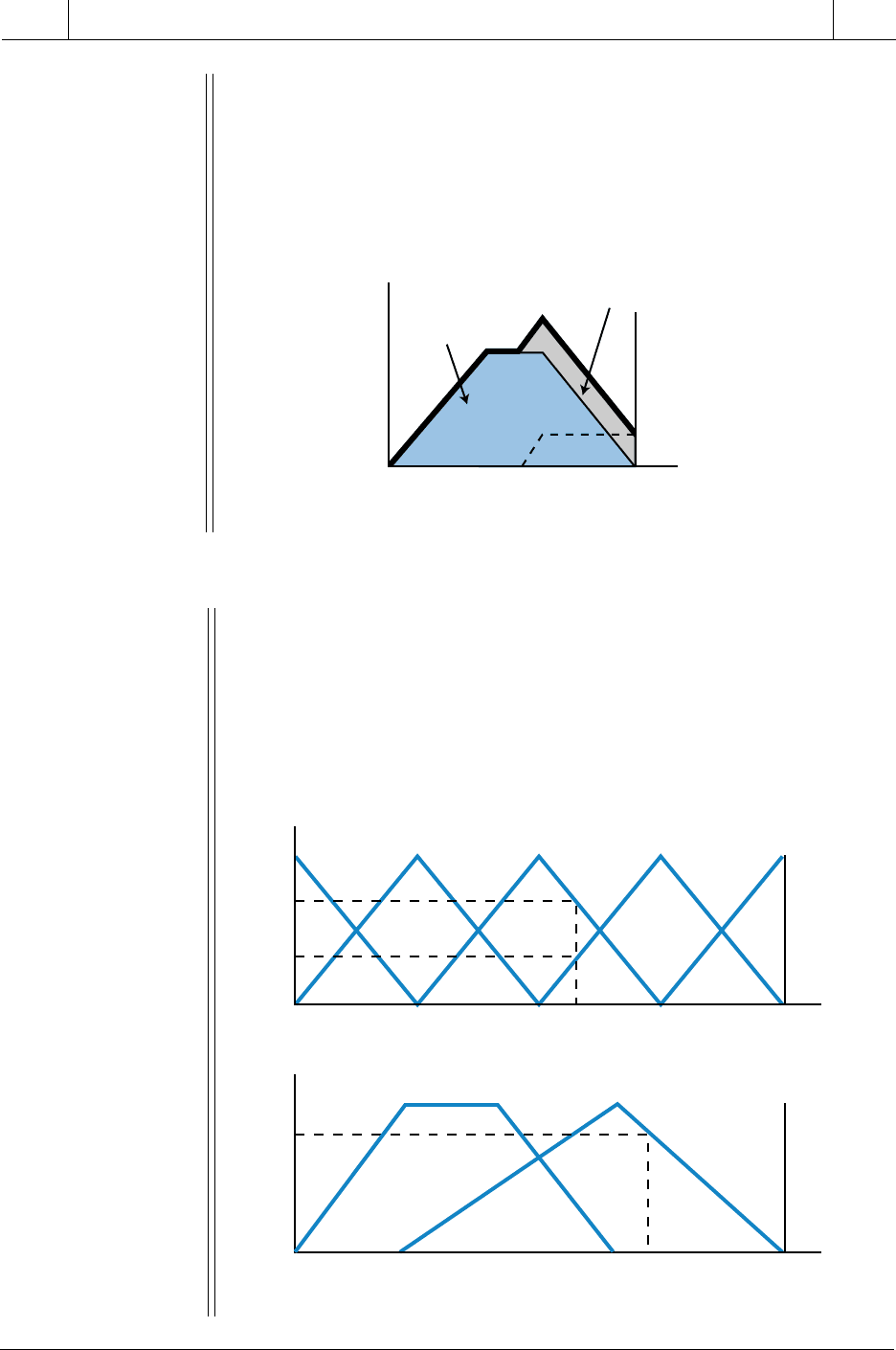
816
SECTION
5
Advanced PLC
Topics and Networks
Industrial Text & Video Company 1-800-752-8398
www.industrialtext.com
CHAPTER
17
Fuzzy
Logic
(b) Figure 17-29 shows the logical sum that the fuzzy controller will
perform. This logical sum is the result of geometrically adding the
areas of the two outcomes (0.75ZR and 0.25PL) to form one graphic
output, from which a final output (fuzzy output
FO
) will be selected
during defuzzification. This output value will then be sent to the control
field device.
EXAMPLE 17-3
Figure 17-30 illustrates two input fuzzy sets, one with five labels and
the other with two labels, while Figure 17-31 shows one fuzzy output
set with five labels. The rules that govern the system (as defined by the
expert) are shown in Figure 17-31a in matrix form for a maximum of 10
possible combinations.
Figure 17-29. Outcome curve for Example 17-2.
Figure 17-30. Fuzzy input sets for input
X
1
and input
X
2
.
0% 100%
60%
1
0.6
0.4
0
Grade
NMNL ZR PM PL
Input
X
1
0% 100%75%
1
0.8
0
Grade
NM ZR
Input
X
2
0% 100%
1
0
Grade
Output
FO
This portion due
to 0.75ZR
This portion due to 0.25PL
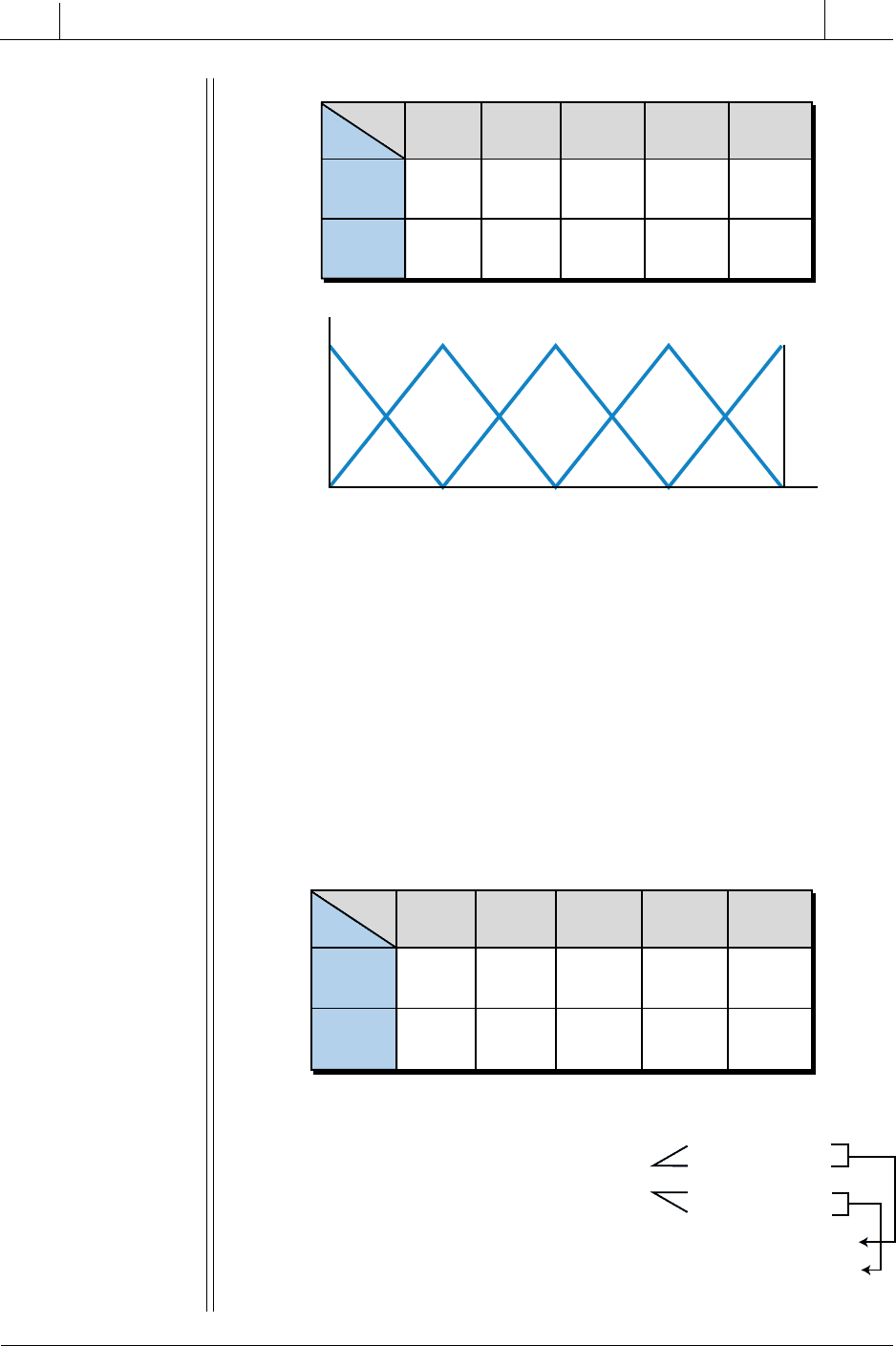
817
CHAPTER
17
Fuzzy
Logic
SECTION
5
Advanced PLC
Topics and Networks
Industrial Text & Video Company 1-800-752-8398
www.industrialtext.com
Figure 17-31. (a) Rule matrix and (b) fuzzy set.
(a) Indicate the rules that are triggered for the two input conditions
X
1
= 60% and
X
2
= 75%, as well as all the possible outcomes of the rules’
triggered inputs. Also, indicate the outputs that will be selected. (b)
Illustrate the selected outcomes and the logical outcome summation
that will be used for defuzzification.
S
OLUTION
(a) Figure 17-32 illustrates the two rules that will be triggered due to
inputs
X
1
and
X
2
. Input
X
1
will intercept membership functions ZR and
PM at grades 0.6 and 0.4, respectively. Input
X
2
will intercept ZR at a
Figure 17-32. Triggered rules.
NL NS PS PLZR
NL NM ZR PMNM
NM
NM
ZR ZR PM PLZR
X
2
X
1
Output Rule Matrix
(a)
0% 100%
1
0
Grade
NMNL ZR PM PL
Output
Y
1
(b)
NL NM PM PLZR
NL NM ZR PMNM
NM
NM
ZR ZR PM PLZR
X
2
X
1
Output Rule Matrix
IF
X
1
= ZR AND
X
2
= ZR
X
1
= 0.6ZR and 0.4PM
X
2
= 0.8ZR
THEN
Y
1
= ZR
IF
X
1
= PM AND
X
2
= ZR
Select
Y
1
= ZR outcome of 0.6
THEN
Y
1
= PM
0.6ZR (due to
X
1
)
0.8ZR (due to
X
2
)
0.4PM (due to
X
1
)
0.8PM (due to
X
2
)
Outcome
Select
Y
1
= PM outcome of 0.4
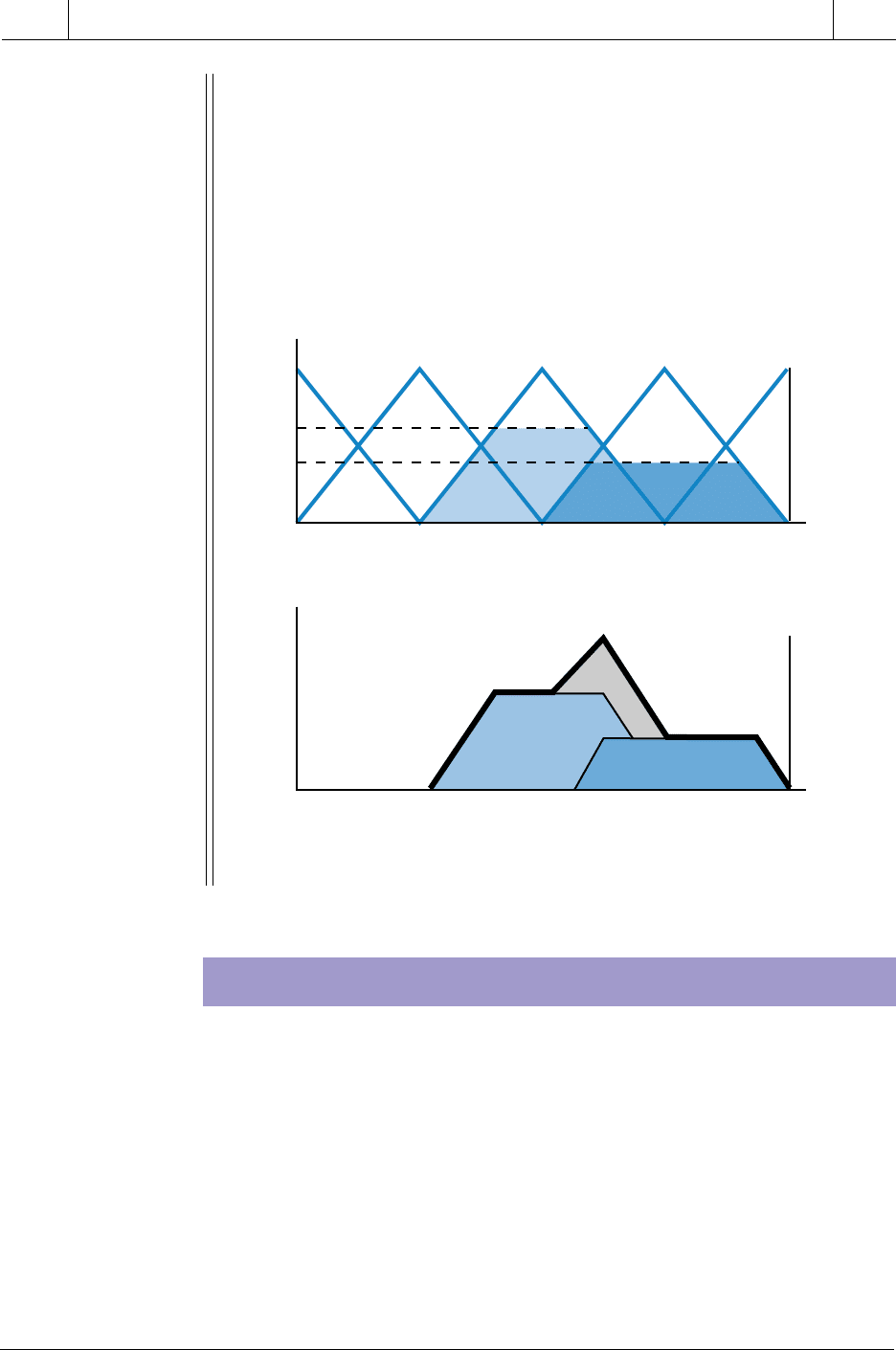
818
SECTION
5
Advanced PLC
Topics and Networks
Industrial Text & Video Company 1-800-752-8398
www.industrialtext.com
CHAPTER
17
Fuzzy
Logic
DEFUZZIFICATION COMPONENTS
Figure 17-33. (a) Triggered outputs and (b) outcome curve.
grade of 0.8. Figure 17-30 presented these grade levels. Because the
rules are linked with AND functions, each rule will have two outputs, of
which the one with the lowest value will be chosen for the logical sum
of the outputs.
(b) Figure 17-33 illustrates the two selected outputs from the two
triggered rules and the resulting output after the two rule outcomes are
logically added.
The final output value from the fuzzy controller depends on the
defuzzification method used to compute the outcome values corresponding to
each label. The defuzzification process examines all of the rule outcomes after
they have been logically added and then computes a value that will be the
final output of the fuzzy controller. The PLC then sends this value to the
output module. Thus, during defuzzification, the controller converts the fuzzy
output into a real-life data value (e.g., 1720 counts).
There are many defuzzification methods, but all are based on mathematical
algorithms. The two most common defuzzification methods are:
(a)
1
0.6
0.4
0
Grade
NMNL ZR PM PL
Output
Y
1
0% 100%
1
0
Grade
Output
Y
1
0% 100%
(b)
